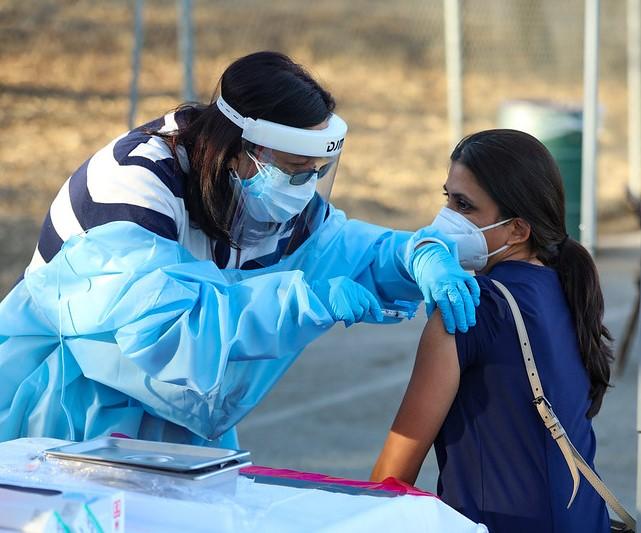Risk-based strategies and analytics-based phone outreach could help target marginalized and high-risk populations for COVID-19 vaccination, preventing infections and poor outcomes, two new studies suggest.
Risk-based strategies outperform others
In the first study, published today in JAMA Health Forum, Kaiser Permanente researchers used a decision analytical model to simulate the effects of random, Centers for Disease Control and Prevention (CDC), age-based, and combination risk strategies of vaccine allocation on related hospitalizations, deaths, and household transmission among Kaiser health plan members in Oakland, California, from May 1 to Dec 31, 2020.
During the 250 simulations, they also evaluated vaccine distribution by race and neighborhood deprivation scores over time.
The study authors said that they were motivated to conduct the study by the scarcity of research on ways to use electronic health records (EHRs) to improve COVID-19 vaccine allocation, especially when supplies are limited.
They noted that while the CDC's Advisory Committee on Immunization Practices tried to balance risk factors for COVID-19 infection and poor outcomes with social and equity priorities when recommending COVID vaccine allocation, implementing that strategy has been difficult for many states. "A key limitation has been the availability of data needed to implement the ACIP guidelines," they wrote.
The study involved 3,202,679 patients 18 years and older with an average age of 48.2 years, of whom 52.4% were women, 19.1% were Asian, 6.4% were Black, 20.1% were Hispanic, and 43.4% were White. Of all patients, 1.1% tested positive for COVID-19.
Risk-based strategies yielded the largest reductions in avoidable hospitalizations (4,954), followed by the age-based (4,362), and CDC proxy (4,085) strategies. The random strategy was by far the least effective in reducing poor outcomes. Risk-based strategies also prevented the most avoidable deaths (1,040) and household transmissions (probability of infection strategy, 3,176; probability of infection and hospitalization approach, 2,598) and, along with the CDC approach, resulted in vaccination of the highest percentages of Hispanic and Black patients.
The combination strategy based on the probability of both adverse outcomes and infections achieved a 100% vaccination rate for Hispanic patients and 90% for Black patients, while the combination approach based on probability of infection alone generated 100% and 96% vaccination rates, respectively. Over the study, 7,867 simulated patients were hospitalized, and 675 died.
Vaccination rates using the CDC approach were 95% for Hispanic patients and 74% for Black patients and were 68% and 75%, respectively, under the age-based approach. The risk-based strategies were estimated to result in the highest early vaccination rates of patients living in areas with high neighborhood deprivation scores.
Informing vaccine allocation priorities
Patients who tested positive for COVID-19 during the study tended to be younger (average age, 43.4 vs 48.2 years), had fewer underlying medical conditions (Comorbidity Point Score version 2 [COPS2] score, 14.2 vs 14.7), and were less likely to be White (23% vs 44%) than those who tested negative or weren't tested.
Of patients who tested positive, 9.4% were hospitalized within 30 days of their diagnosis. Hospitalized patients were older (average age, 59.5 vs 41.8 years), had more underlying conditions (average COPS2 score, 30.4 vs 12.6), and were more severely ill (abbreviated Laboratory-Based Acute Physiology Score, 1.8 vs 0.3).
Patients at high risk for infection were more likely to be Hispanic (60% to 70% vs less than 5%) or Black (12% to 16% vs 0% to 9%), to test positive for COVID-19 (20 to 24 vs 4.9 per 1,000 people), and to have higher mean neighborhood deprivation index scores (0.4 to 0.5 vs -1.1 to -0.2). Patients at high risk for poor outcomes were older (age, 65-70 vs 30 to 50 years) and more likely to be men (60% vs 40% to 50%) than those at lower risk.
"The estimates produced in this simulation can help inform vaccine allocation approaches in locales with limited vaccine supply or potentially in future periods of vaccine distribution for COVID-19 or other similar pandemics," the researchers wrote. "In addition, risk-based approaches could be used to inform public health and community engagement campaigns that are designed to increase vaccination uptake among groups that remain undervaccinated."
Phone outreach to marginalized patients
The second study, led by researchers at the University of North Carolina at Chapel Hill and published yesterday in JAMA Oncology, involved using an analytics- and EHR-based strategy to identify and contact cancer patients who might benefit from targeted nonelectronic communication on COVID-19 vaccine safety, eligibility, and logistics.
Eligible patients were those who underwent cancer therapy within the last year and had scheduled follow-up appointments or who didn't have an active patient portal account or valid email on file, or lived in a county with a poverty rate above 20%.
From January to March 2021, the researchers identified 536 potentially marginalized patients eligible for COVID-19 vaccination. Of that number, 61% were White, 32% were Black, and 14% lived in counties with persistent poverty. More than 99% of patients were called, with 67% reached and 9% receiving voicemails.
Of Black patients, 75% were reached, and 93% from counties with high poverty levels were contacted. Overall, the average duration of the calls was 4.3 minutes. As of Apr 2, 26% of patients were confirmed to have received vaccination using EHR review or self-report, and another 4% had scheduled a vaccine appointment.
The study authors noted that rates of electronic patient portals and Internet access are lower among patients living in rural areas, those with low socioeconomic status, and racial minorities and that cancer patients are at high risk for COVID-19 complications. "This novel intervention demonstrated the potential benefits of an analytics-based strategy to reach marginalized patients at high risk for exclusion from electronic outreach and may be built on for future outreach programs," they wrote.
The researchers said that the vaccination rate reported in the study is probably an underestimate, because vaccines received or scheduled at sites other than the university weren't captured in the EHR. "No control arm was included; thus, we do not know how many patients would have received vaccines without this initiative," they said.
"However, these patients would likely have been missed by our electronic outreach efforts, and preliminary qualitative feedback from patients suggests that the calls aided them in their decision to proceed with vaccination."
The phone calls also identified many patients with unmet clinical or social needs, they said. "While not the intended goal of this project, and thus not consistently tracked, mitigating barriers became an integral part of this effort and may have yielded positive patient experiences and increased the ability for patients to become vaccinated."























